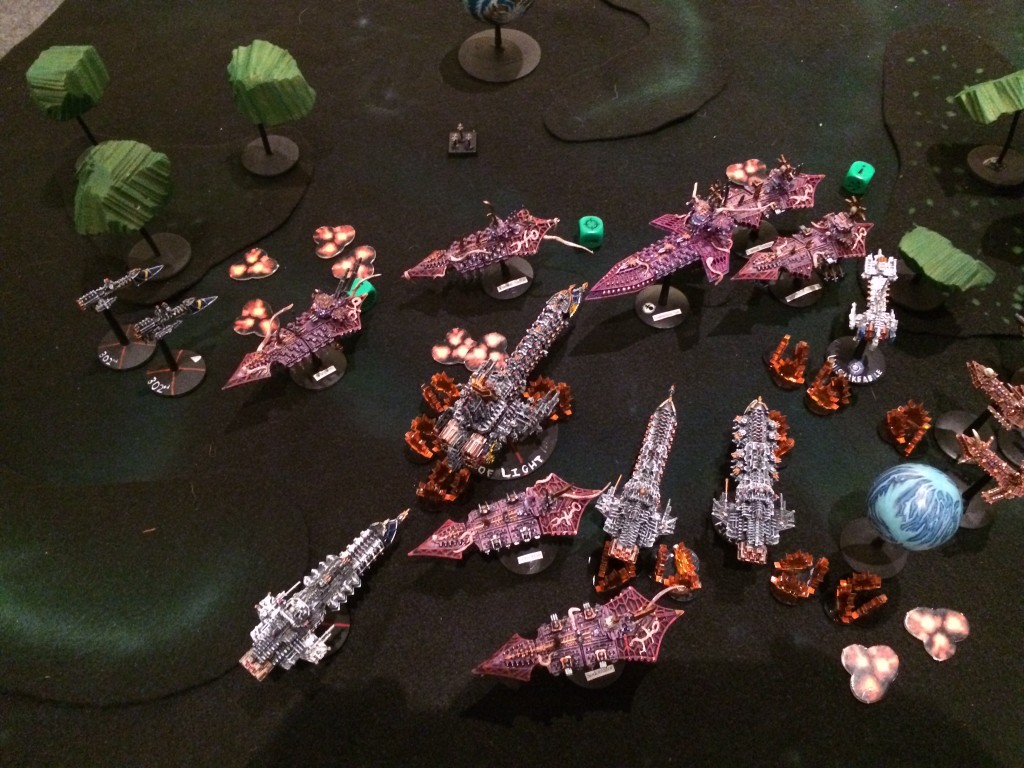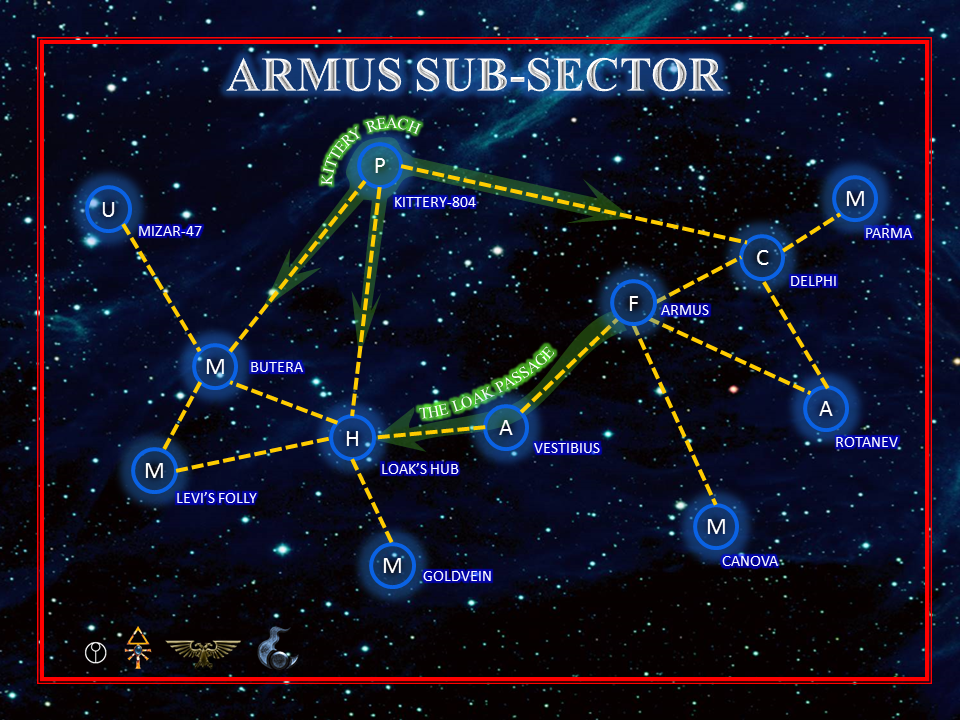This post is intended to establish the groundwork for the setting of the 2016 Man Battlestations BFG campaign, the Armus Sub-sector. The intent is to provide those participating in the campaign a common frame of reference with which they can forge their own narratives for the individual games they play within the campaign. The background laid down here is from the Imperial perspective, which leaves plenty of latitude for interpretation by players who will undoubtedly prefer to see events through the eyes of their chosen faction!
Sector Overview
The Armus sub-sector was brought into the Imperial fold during the days of the Great Crusade ten thousand years ago. Since that time, it has become a heavily developed and settled sector, thanks to its strategic position to the galactic west of Holy Terra. This sub-sector has proven a vital source of men and materiel for several of the Imperium’s most recent conflicts, including the Damocles Gulf crusade against the Tau.
785.M41: A Growing Shadow
For the past several millenia, Sub-sector Armus had been relatively tranquil. Like many Imperial sub-sectors, the sub-sector had seen occasional activity from both Ork and Eldar pirates. The relative handful of Imperial Navy ships (a few light cruisers and escort squadrons) that were permanently assigned to the sub-sector, combined with each system’s defense auxila, had typically been enough to keep the corsairs at bay. However, the number of Ork attacks on Imperial shipping began sharply increasing starting in 783.M41, giving rise to fears that a full-blown WAAAGH! Might have been brewing. By 784.M41, rumors surfaced of a Tau explorator fleet being sighted in several systems. These rumors had to be taken seriously, as the young xenos empire lay just a bit further to the galactic west. The fact that the Damocles Gulf crusade 40 years earlier was somewhat indecisive means that there remained real potential for a Tau attack on the sub-sector. Finally, and perhaps most ominously, warp travel to and from the sub-sector, as well as astropathic communications, grew steadily less and less reliable towards the end of 784.M41. Such portents are commonly associated with major Chaos incursions, a dire threat that could not be ignored. It is for these reasons that the Imperial Governor of the sub-sector requested re-inforcements, which arrived in early 785.M41. These reinforcements were in the form of a powerful task force that was detached from Battle Group Fortitas with all haste. Arriving with the ships was a delegation from the Inquisition led by Inquisitor Lexon of the Ordo Hereticus, who harbored a suspicion that heresy has taken root among the Imperial citizenry in Armus sub-sector. He could not yet know just how well founded his fears would turn out to be. With the arrival of the Imperial Navy’s reinforcements, the Armus sub-sector was a primed tender box ready to erupt into open warfare for the first time in thousands of years, almost as if a malign intellect had engineered it that way for its own nefarious purposes. – excerpted from “An Imperial History of The Armus War” by Dorman J. Poltera, 173.M42.
A Guide to the Arums Sub-Sector
What follows is a brief overview of the major planets that comprise the sub-sector, including any notable features.
Armus
The Armus system is the oldest human-inhabited world in the region. Imperial scholars are uncertain as to when the first human colonies were established on the planet; archaeological evidence and fragmentary records from the time of the Great Crusade that describe the planet as possessing a flourishing, if technologically regressed, human population suggest that Armus was originally colonized during the Dark Age of Technology. The Adeptus Mechanicus laid claim to the system sometime during the 32nd Millennium, and have since turned it into a vastly productive Forge World. Armus Prime is also the capital planet of the entire sub-sector, and the Imperial Governor maintains close ties with the Mechanicus. The system is also home to the most developed shipyards in the sector, which makes it ideal for the Imperial Navy’s main base in the area.
Loak’s Hub
While Armus may be the most industrially productive system in the sector, Loak’s Hub has by far the largest population. Discovered and later named for the famed Rouge Trader, Maximilius Loak, Loak’s Hub sits at the center of no less than 5 stable warp routes to other systems, three of which boast significant mining operations. Loak’s Hub provides a source of cheap labor for numerous mining consortiums, which bring ore into Loak’s Hub for processing and trans-shipment to Armus. The warp routes connecting Armus and Loak, known as the Loak Passage, are heavily traveled as a result. The Passage has been carefully and clearly marked, allowing Navigators to easily and rapidly make the transit. The trade between Loak’s Hub, its nearby mining worlds, and Armus has made the elite executives on Loak’s Hub rich beyond all imagining of the average Imperial citizen, a condition which has led to internal strive inside the planet’s many vast hives numerous times over the centuries. Each time, the unrest has been quashed by bloody crack-downs, with the ringleaders being publicly executed in the grimest and bloodiest possible manner and all those even thought to be involved getting shipped off-world to the penal colony at Kittery-804.
Vestibius
Lying halfway between Armus and Loak’s Hub along the Loak Passage, Vestibius makes a convenient port of call for the large amount of merchant traffic plying the Passage. Many of these ships will pause to refuel, make temporary repairs, or take on cargo in one of the system’s many orbital facilities. Vestibius’s main inhabited world is one of only a small handful of planets in the entire sub-sector that is a net exporter of food. As a result, its fertile fields are commonly referred to as the “breadbasket” of Loak’s Hub.
Goldvein, Levi’s Folly, and Butera
All three of these systems have relatively small permanent populations, as there is little in the way of habitable planets in all three of these systems. However, they are incredibly rich in various elements essential to feeding the Imperial war machine, which ensures that there is a steady parade of mining craft, supply vessels, and other such craft flowing in, out, and around these systems.
Mizar-47
Millennia ago, long before the Imperium of Man came to the Armus Sub-Sector, a great calamity befell this system. The star in Mizar-47 is highly unstable; at some point, it appears that a large portion of the star’s mass exploded outward into the system with the destructive force of a small nova. This blast reduced the three rocky inner planets to cinders, and caused great trauma to the gas-giants in the outer reaches of the system. This ancient cataclysm also appears to have sealed off a warp route that should have existed between Mizar-47 and Kittery-804, leaving only the route to Butera. The Imperium’s best scientific minds have been able to ascertain no possible natural cause for this phenomenon, giving rise to all manner of theories that the destruction wrought in this system was perhaps the result of some long-forgotten war between unknown Xenos empires, or even the result of some unfathomable action by the Arch Enemy. Whatever the cause, though, the fact is that Mizar-47 is isolated, blasted, and inhospitable. There is no permanent Imperial presence in the system, though the Imperial Navy conducts sweeps every few years to ensure that it is not being used as a base by pirates.
Kittery-804
This system is used as a penal colony by the Imperial sub-sector government. The system lies at the end of long warp routes from Delphi, Loak’s Hub, and Butera, passages which are made even more hazardous by an odd set of persistent disruptions in the Warp around the system, referred to as the Kittery Reach by Navigators. There is only one small rocky inner planet and two large gas giants in Kittery. The single rocky world is frozen in an eternal ice-age due to the distance from the star. The vast Imperial penal complexes have been burrowed out of the ice by the Mechanicus, and house millions of inmates. Guards at some of these complexes also whisper stories of a Mechanicus project to expand one of the complexes that dug too deeply and found some sort of bizarre Xenos artifacts, including metal walls that seemed to almost pulse with some sort of strange green energy. No one has ever found these supposed diggings, however, leading many to doubt such a thing ever happened. Even if those stories are true, it is clear that Kittery is firmly under Imperial control now.
Canova
The Canova System was one of the early systems that was tapped to support the burgeoning Manufactorums that the Mechanicus established on Armus Prime. As a result, many of the most lucrative commodities that were once present in Canova have long since been stripped away. This gives the system the feel of a boom town gone bust, with many long-abandoned mining operations dotting its planets and moons. However, there are still some resources worth mining, and a small number of Imperial miners eke out a lean existence here doing jobs that, in many cases, have been in their families for more than a hundred generations.
Rotanev
This system has been given over to agricultural production in order to support the burgeoning population growth seen in the sub-sector. The agricultural production made possible in Rotanev is a technological marvel, the result of thousands of years worth of terraforming performed by the Adeptus Mechanicus.
Delphi
Armus may be the technological brain of the sub-sector, and Loak’s Hub its principal population center, but Delphi is its spiritual and cultural heart. Delphi Prime was once an Agri-world, but when the terraforming project at Rotanev began to bear fruit the world’s governor was granted permission to release large tracts of land for development. Many of the rich and wealthy Imperial citizens from Loak’s Hub rushed to establish sprawling estates on Delphi, a refuge from the crowding and pollution endemic of any Imperial hive world. The Adeptus Ministorum was also quick to establish several grand shrines and cathedrals on the planet, making it a popular pilgrimage destination for the Faithful from both within the Armus Sub-sector and without. Such development is strictly controlled by the Governor of Delphi, however, to ensure that the world retains much of its rugged natural beauty. In fact, the system remains a net exporter of food, though it now focuses more on the delicacies that only the rich can afford, rather than staples for the masses.
Parma
Due to its relative isolation mining operations on Parma have only begun in the last few centuries, despite its mineral wealth. The greater expense of shipping material from Parma to Armus meant that it was only economical to do so once the stock of those materials was exhausted in closer systems, such as Canova. As a result, there is now a small, but growing, Imperial industrial presence in the system. The third planet shows excellent prospects for large-scale terraforming, such as was performed in Rotanev.
And there you have it! Welcome to the Armus Sub-sector. Stay tuned for additional updates as the campaign progresses!


